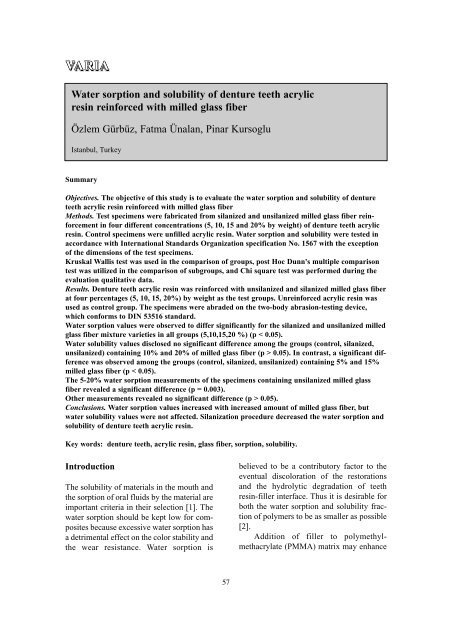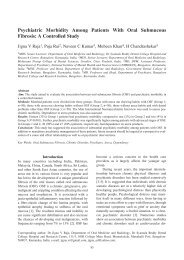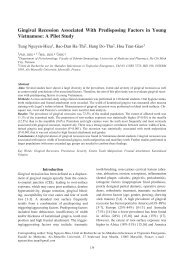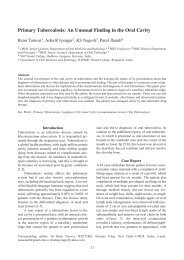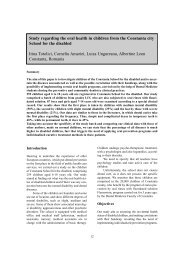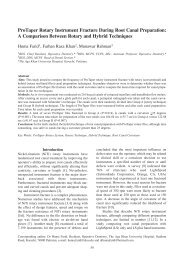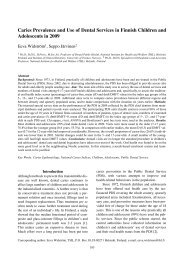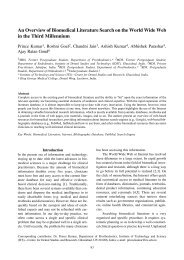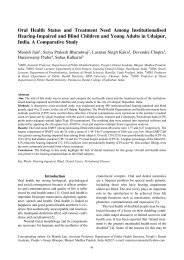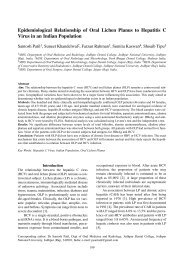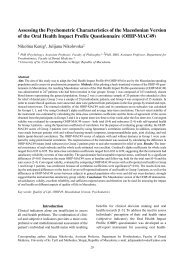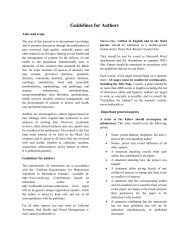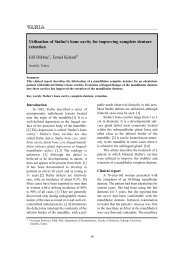Water sorption and solubility of denture teeth acrylic resin reinforced ...
Water sorption and solubility of denture teeth acrylic resin reinforced ...
Water sorption and solubility of denture teeth acrylic resin reinforced ...
Create successful ePaper yourself
Turn your PDF publications into a flip-book with our unique Google optimized e-Paper software.
VARIA<br />
<strong>Water</strong> <strong>sorption</strong> <strong>and</strong> <strong>solubility</strong> <strong>of</strong> <strong>denture</strong> <strong>teeth</strong> <strong>acrylic</strong><br />
<strong>resin</strong> <strong>reinforced</strong> with milled glass fiber<br />
Özlem Gürbüz, Fatma Ünalan, Pinar Kursoglu<br />
Istanbul, Turkey<br />
Summary<br />
Objectives. The objective <strong>of</strong> this study is to evaluate the water <strong>sorption</strong> <strong>and</strong> <strong>solubility</strong> <strong>of</strong> <strong>denture</strong><br />
<strong>teeth</strong> <strong>acrylic</strong> <strong>resin</strong> <strong>reinforced</strong> with milled glass fiber<br />
Methods. Test specimens were fabricated from silanized <strong>and</strong> unsilanized milled glass fiber reinforcement<br />
in four different concentrations (5, 10, 15 <strong>and</strong> 20% by weight) <strong>of</strong> <strong>denture</strong> <strong>teeth</strong> <strong>acrylic</strong><br />
<strong>resin</strong>. Control specimens were unfilled <strong>acrylic</strong> <strong>resin</strong>. <strong>Water</strong> <strong>sorption</strong> <strong>and</strong> <strong>solubility</strong> were tested in<br />
accordance with International St<strong>and</strong>ards Organization specification No. 1567 with the exception<br />
<strong>of</strong> the dimensions <strong>of</strong> the test specimens.<br />
Kruskal Wallis test was used in the comparison <strong>of</strong> groups, post Hoc Dunn's multiple comparison<br />
test was utilized in the comparison <strong>of</strong> subgroups, <strong>and</strong> Chi square test was performed during the<br />
evaluation qualitative data.<br />
Results. Denture <strong>teeth</strong> <strong>acrylic</strong> <strong>resin</strong> was <strong>reinforced</strong> with unsilanized <strong>and</strong> silanized milled glass fiber<br />
at four percentages (5, 10, 15, 20%) by weight as the test groups. Un<strong>reinforced</strong> <strong>acrylic</strong> <strong>resin</strong> was<br />
used as control group. The specimens were abraded on the two-body abrasion-testing device,<br />
which conforms to DIN 53516 st<strong>and</strong>ard.<br />
<strong>Water</strong> <strong>sorption</strong> values were observed to differ significantly for the silanized <strong>and</strong> unsilanized milled<br />
glass fiber mixture varieties in all groups (5,10,15,20 %) (p < 0.05).<br />
<strong>Water</strong> <strong>solubility</strong> values disclosed no significant difference among the groups (control, silanized,<br />
unsilanized) containing 10% <strong>and</strong> 20% <strong>of</strong> milled glass fiber (p > 0.05). In contrast, a significant difference<br />
was observed among the groups (control, silanized, unsilanized) containing 5% <strong>and</strong> 15%<br />
milled glass fiber (p < 0.05).<br />
The 5-20% water <strong>sorption</strong> measurements <strong>of</strong> the specimens containing unsilanized milled glass<br />
fiber revealed a significant difference (p = 0.003).<br />
Other measurements revealed no significant difference (p > 0.05).<br />
Conclusions. <strong>Water</strong> <strong>sorption</strong> values increased with increased amount <strong>of</strong> milled glass fiber, but<br />
water <strong>solubility</strong> values were not affected. Silanization procedure decreased the water <strong>sorption</strong> <strong>and</strong><br />
<strong>solubility</strong> <strong>of</strong> <strong>denture</strong> <strong>teeth</strong> <strong>acrylic</strong> <strong>resin</strong>.<br />
Key words: <strong>denture</strong> <strong>teeth</strong>, <strong>acrylic</strong> <strong>resin</strong>, glass fiber, <strong>sorption</strong>, <strong>solubility</strong>.<br />
Introduction<br />
The <strong>solubility</strong> <strong>of</strong> materials in the mouth <strong>and</strong><br />
the <strong>sorption</strong> <strong>of</strong> oral fluids by the material are<br />
important criteria in their selection [1]. The<br />
water <strong>sorption</strong> should be kept low for composites<br />
because excessive water <strong>sorption</strong> has<br />
a detrimental effect on the color stability <strong>and</strong><br />
the wear resistance. <strong>Water</strong> <strong>sorption</strong> is<br />
believed to be a contributory factor to the<br />
eventual discoloration <strong>of</strong> the restorations<br />
<strong>and</strong> the hydrolytic degradation <strong>of</strong> <strong>teeth</strong><br />
<strong>resin</strong>-filler interface. Thus it is desirable for<br />
both the water <strong>sorption</strong> <strong>and</strong> <strong>solubility</strong> fraction<br />
<strong>of</strong> polymers to be as smaller as possible<br />
[2].<br />
Addition <strong>of</strong> filler to polymethylmethacrylate<br />
(PMMA) matrix may enhance<br />
57
OHDMBSC - Vol. IV - No. 4 - December, 2005<br />
the mechanical properties <strong>of</strong> the polymerized<br />
<strong>resin</strong> but there is a great concern about<br />
the stability <strong>of</strong> PMMA in aqueous environments<br />
[3]. This is mainly because the fillermatrix<br />
interface provides paths <strong>of</strong> facilitated<br />
diffusion similar to grain boundary diffusion<br />
[3,4]. <strong>Water</strong> <strong>sorption</strong> in composite materials<br />
is a diffusion-controlled process <strong>and</strong> occurs<br />
mainly in the <strong>resin</strong> matrix [5,6].<br />
Glass fibers were shown to be most<br />
suitable for dental applications because <strong>of</strong><br />
good cosmetic qualities <strong>and</strong> good bonding<br />
<strong>of</strong> glass fibers to the polymer matrix via<br />
silane coupling agents [7,8]. It has been<br />
reported that glass reinforcement significantly<br />
affects the water <strong>sorption</strong> <strong>and</strong> <strong>solubility</strong><br />
<strong>of</strong> <strong>denture</strong> base <strong>resin</strong> [9,10]. <strong>Water</strong> can<br />
destroy the fiber-polymer matrix bond <strong>and</strong><br />
plasticization <strong>of</strong> the polymer matrix by<br />
water molecules <strong>and</strong> these leads to strength<br />
reduction <strong>of</strong> glass fiber <strong>reinforced</strong> composites<br />
[11]. An aqueous environment such as<br />
the oral cavity can induce corrosion effects<br />
in the surface <strong>of</strong> glass fibers because <strong>of</strong> the<br />
water that diffuses through the polymer<br />
matrix [12]. This can lead to a reduction <strong>of</strong><br />
the mechanical properties <strong>and</strong> changes in<br />
the composite structure [13].<br />
The study in this paper is part <strong>of</strong> a continuing<br />
study <strong>of</strong> the reinforcement <strong>of</strong> a <strong>denture</strong><br />
<strong>teeth</strong> <strong>acrylic</strong> <strong>resin</strong> with milled glass<br />
fiber (mgf). The aim <strong>of</strong> this study was to<br />
determine the water <strong>sorption</strong> <strong>and</strong> <strong>solubility</strong><br />
<strong>of</strong> <strong>denture</strong> <strong>teeth</strong> <strong>acrylic</strong> <strong>resin</strong> <strong>reinforced</strong> with<br />
mgf at different weight concentrations.<br />
Materials <strong>and</strong> Methods<br />
Specimen preparation:<br />
The specimen dimensions were 16 mm<br />
in diameter <strong>and</strong> 7 mm in thickness. Denture<br />
<strong>teeth</strong> <strong>acrylic</strong> <strong>resin</strong> (Rutinium Dental<br />
Manufacturing spa Ravigo, Italy) polymer/monomer<br />
ratio was 20g/10 ml by<br />
weight (wt) for all the specimens (unmodified<br />
or modified with fiber). The milled E<br />
glass fiber (1.2 µm in diameter, 0.8mm in<br />
length <strong>and</strong> 2.7g/cm 3 in density) was supplied<br />
from Cam Elyaf A. Þ, Çayýrova,<br />
Turkey. The percentages <strong>of</strong> milled glass<br />
fiber used were 5, 10, 15 <strong>and</strong> 20% by wt.<br />
The silane coupling agent, A-174, 3-<br />
methacryloxypropyl trimethoxy silane (3-<br />
MPS) was supplied from Union Carbide,<br />
UK.<br />
The <strong>denture</strong> <strong>teeth</strong> <strong>acrylic</strong> <strong>resin</strong> was<br />
polymerized at 175 C under pressure <strong>of</strong> 160<br />
Barr for 3 minutes (Elimko 2200<br />
Hidrocontrol Machine, Ankara, Turkey) <strong>and</strong><br />
then cooled with water under a pressure <strong>of</strong><br />
160 Barr for 3 minutes. After demolding, the<br />
specimens were removed <strong>and</strong> finished to<br />
remove excess material by honing with fine<br />
emery paper. All specimens were prepared<br />
with the same procedure in the same mold<br />
<strong>and</strong> carried out at room temperature (23<br />
1C).<br />
The nine groups <strong>of</strong> specimens (totally<br />
90 specimens) were divided as follows: 10<br />
specimens <strong>of</strong> unfilled <strong>acrylic</strong> <strong>resin</strong> used as a<br />
control group (C) <strong>and</strong> the others test groups<br />
– Acrylic <strong>resin</strong> modified with 5, 10, 15, 20%<br />
by wt unsilanized mgf added to polymer (n<br />
= 10, totally 40 specimens) <strong>and</strong> Acrylic <strong>resin</strong><br />
modified with 5, 10, 15, 20% by wt<br />
silanized mgf added to polymer (n = 10,<br />
totally 40 specimens).<br />
<strong>Water</strong> <strong>sorption</strong> <strong>and</strong> <strong>solubility</strong> testing:<br />
<strong>Water</strong> <strong>sorption</strong> <strong>and</strong> <strong>solubility</strong> were tested<br />
according to ISO specification 1567 [14],<br />
with the exception <strong>of</strong> the dimensions <strong>of</strong> the<br />
test specimens. Control <strong>and</strong> test specimens<br />
were measured with fine digital micrometer<br />
(Mitutoya Digimatic Caliper<br />
500154/CD15C, Engl<strong>and</strong>) <strong>and</strong> their volumes<br />
(V) (including fibers) were determined<br />
for calculation <strong>of</strong> water <strong>sorption</strong> <strong>and</strong><br />
<strong>solubility</strong> values. After the specimens were<br />
dried for 23 hours at 37°C in desiccators, the<br />
specimens were weighed (m 1 ). All speci-<br />
58
OHDMBSC - Vol. IV - No. 4 - December, 2005<br />
mens were stored in distilled water in a thermostatically<br />
controlled water bath<br />
(Elektromag-M96K <strong>Water</strong> Bath, Turkey) at<br />
37°C for a week, then weighed (m 2 ). Then<br />
the specimens were again dried for 23 hours<br />
at 37°C in desiccators, after that being<br />
weighed (m 3 ). All specimens were weighed<br />
until the mass was constant to an accuracy<br />
<strong>of</strong> 0.0002 mg with an analytic balance<br />
(Metler H20, nearest 0.001 mg<br />
Switzerl<strong>and</strong>). After completing the storage<br />
periods, the water <strong>sorption</strong> (W sp ) <strong>and</strong> <strong>solubility</strong><br />
(W sI ) values (mg/mm³) were measured<br />
<strong>and</strong> calculated as described below:<br />
W sp : (m 2 -m 1 )/V<br />
W sl : (m 1 -m 3 )/V<br />
Statistical analysis:<br />
Statistical calculations were performed with<br />
GraphPad Prisma V.3 program for<br />
Windows. Besides st<strong>and</strong>ard descriptive statistical<br />
calculations (mean <strong>and</strong> st<strong>and</strong>ard<br />
deviation), Kruskal Wallis test was used in<br />
the comparison <strong>of</strong> groups, post Hoc Dunn’s<br />
multiple comparison test was utilized in the<br />
comparison <strong>of</strong> subgroups, <strong>and</strong> Chi square<br />
test was performed during the evaluation<br />
qualitative data. Statistical significance level<br />
was established at p < 0.05.<br />
Results<br />
<strong>Water</strong> <strong>sorption</strong> values were observed to differ<br />
significantly for the silanized <strong>and</strong> unsilanized<br />
milled glass fiber mixture varieties<br />
in the 5, 10, 15, 20% groups (Table 1, 2).<br />
Table 1. Means, st<strong>and</strong>ard deviations <strong>and</strong> statistical comparisons for water <strong>sorption</strong> <strong>and</strong> <strong>solubility</strong><br />
values (mg/mm³) <strong>of</strong> all groups<br />
The weight changes recorded in the<br />
5-20% <strong>of</strong> unsilanized milled glass mixtures<br />
displayed a statistically significant difference<br />
in water <strong>sorption</strong>. Both 15% <strong>and</strong> 20%<br />
unsilanized mgf containing groups displayed<br />
increased water <strong>sorption</strong> compared<br />
to the 5% unsilanized mgf group, p value<br />
being respectively: (p < 0.05) <strong>and</strong> (p < 0.01)<br />
(Table 3). Other measurements revealed no<br />
significant difference (p > 0.05).<br />
In water <strong>solubility</strong> values, a significant<br />
difference was observed between the<br />
silanized <strong>and</strong> the unsilanized groups containing<br />
5% <strong>of</strong> mgf (p = 0.013).<br />
59
OHDMBSC - Vol. IV - No. 4 - December, 2005<br />
Table 2. The comparisons <strong>of</strong> subgroups<br />
(<strong>Water</strong> <strong>sorption</strong>)<br />
(<strong>Water</strong> <strong>solubility</strong>)<br />
Dunn's Multiple<br />
Comparison Te st %5 %10 %15 %20 % 5 %15<br />
control /<br />
P < 0.05 P > 0.05 P > 0.05 P > 0.05 P > 0.05 P < 0.05<br />
unsilanized mgf<br />
control /<br />
P < 0.001 P < 0.001 P < 0.001 P 0.05 P > 0.05<br />
silanized mgf<br />
unsilanized /<br />
silanized mgf<br />
P > 0.05 P > 0.05 P > 0.05 P > 0.05 P < 0.05 P < 0.05<br />
mgf: milled glass fibe<br />
In the 15% mgf group, water <strong>solubility</strong> difference<br />
between groups was significant (p =<br />
0.003) (Table 1, 2).<br />
No significant difference <strong>of</strong> water<br />
<strong>solubility</strong> was observed between the 5-20%<br />
measurements <strong>of</strong> the specimens containing<br />
silanized <strong>and</strong> unsilanized mgf (p > 0.05).<br />
Discussion<br />
It has been reported that glass reinforcement<br />
significantly affects the water <strong>sorption</strong> <strong>and</strong><br />
<strong>solubility</strong> <strong>of</strong> <strong>denture</strong> base <strong>resin</strong> [9].<br />
Ladizesky et al [10] studied the water <strong>sorption</strong><br />
<strong>of</strong> <strong>denture</strong> base <strong>acrylic</strong> <strong>resin</strong> <strong>reinforced</strong><br />
with woven polyethylen fiber, adding up to<br />
4-6% <strong>of</strong> the volume. The high fiber content<br />
reduced the water <strong>sorption</strong> by 25%. A study<br />
<strong>of</strong> the water <strong>sorption</strong> <strong>of</strong> continuous unidirectional<br />
glass fiber-<strong>reinforced</strong> (11% by wt)<br />
specimens demonstrated a decrease in water<br />
<strong>sorption</strong> values [9]. Çal et al [15] reported<br />
that the water <strong>sorption</strong> <strong>of</strong> <strong>denture</strong> base polymers<br />
is lower when the specimens are <strong>reinforced</strong><br />
with glass fibers in continuous <strong>and</strong><br />
woven form. The present study, in accord<br />
with the referred papers, revealed that <strong>denture</strong><br />
<strong>teeth</strong> <strong>acrylic</strong> <strong>resin</strong> with milled glass<br />
fiber incorporation held lower water <strong>sorption</strong><br />
values than did <strong>acrylic</strong> <strong>resin</strong> without<br />
glass. <strong>Water</strong> <strong>sorption</strong> occurs mainly as a<br />
direct ab<strong>sorption</strong> by the <strong>resin</strong>. The glass<br />
filler will not absorb into bulk <strong>of</strong> the material<br />
but can adsorb water onto its surface.<br />
Thus, the amount <strong>of</strong> water <strong>sorption</strong> is<br />
dependent on the <strong>resin</strong> content <strong>of</strong> the composite<br />
<strong>and</strong> the quality <strong>of</strong> the bond between<br />
the <strong>resin</strong> <strong>and</strong> the filler [2].<br />
Well impregnated composites have<br />
theoretically lower water <strong>sorption</strong> than<br />
poorly impregnated composites in which the<br />
fibers are not completely embedded with the<br />
<strong>resin</strong>, which resulted in void in the structure<br />
<strong>of</strong> the polymerized composite that could<br />
increase water <strong>sorption</strong> [9,16-19]. The glass<br />
fillers reduced the quantity <strong>of</strong> water<br />
absorbable material <strong>and</strong> the glass filler didn’t<br />
absorb water <strong>and</strong> thus the water <strong>sorption</strong><br />
<strong>of</strong> glass fiber composite should be less compared<br />
to that <strong>of</strong> the matrix polymer [9].<br />
Table 3. Comparisons <strong>of</strong> concentrations<br />
Dunn's Multiple Comparison Test<br />
<strong>Water</strong> <strong>sorption</strong><br />
Unsilanized<br />
%5 / %10 P > 0.05<br />
%5 / %15 P < 0.01<br />
%5 / %20 P < 0.05<br />
%10 / %15 P > 0.05<br />
%10 / %20 P > 0.05<br />
%15 / %20 P > 0.05<br />
60
OHDMBSC - Vol. IV - No. 4 - December, 2005<br />
Chow et al [20] reported in the paper<br />
are part <strong>of</strong> a continuing study <strong>of</strong> the reinforcement<br />
<strong>of</strong> <strong>acrylic</strong> <strong>denture</strong> base <strong>resin</strong>s<br />
with highly drawn linear polyethylene<br />
fibers. <strong>Water</strong> <strong>sorption</strong> is significantly<br />
reduced by incorporation <strong>of</strong> these fibers,<br />
even though the water diffusion processes as<br />
such remain broadly unaffected. A relative<br />
high water <strong>sorption</strong> value for a composite<br />
may indicate a number <strong>of</strong> possibilities. The<br />
<strong>resin</strong> may contain air voids, introduced during<br />
mixing or placement, <strong>and</strong> another possibility<br />
is that hydrolytic breakdown <strong>of</strong> the<br />
bond between the filler <strong>and</strong> the <strong>resin</strong> has<br />
occurred, allowing ad<strong>sorption</strong> onto the surface<br />
<strong>of</strong> the filler particles [2]. Glass fibers<br />
may cause irregular voids in the composite<br />
structure <strong>and</strong> voids absorb water by means<br />
<strong>of</strong> capillary forces <strong>and</strong> thus may be responsible<br />
for variations in water <strong>sorption</strong> with<br />
increasing percentages [2].<br />
Glass fiber reinforcement affected the<br />
<strong>solubility</strong> values <strong>of</strong> the PMMA specimens<br />
[9]. Fiber inclusion <strong>and</strong> post curing <strong>of</strong> polymer<br />
matrix reduced water <strong>sorption</strong> <strong>and</strong> <strong>solubility</strong><br />
[18]. Results <strong>of</strong> this study show that<br />
the addition <strong>of</strong> unsilanized or silanized glass<br />
fiber to the <strong>denture</strong> <strong>teeth</strong> <strong>acrylic</strong> <strong>resin</strong> either<br />
does not affect or decrease water <strong>solubility</strong>.<br />
The <strong>solubility</strong> behavior <strong>of</strong> composite<br />
<strong>resin</strong> materials will be affected by the type<br />
<strong>of</strong> filler used, the treatment <strong>of</strong> the filler (i.e.<br />
silane treatment) [21,22] as well as air voids<br />
within the composite <strong>resin</strong> material, <strong>of</strong>ten<br />
leading to a decrease <strong>of</strong> mass <strong>of</strong> the material<br />
[23]. This study revealed a decrease in<br />
water <strong>sorption</strong> values <strong>and</strong> generally unaffected<br />
<strong>solubility</strong> with silanization.<br />
Conclusions<br />
The strengthening <strong>of</strong> <strong>denture</strong> <strong>teeth</strong> PMMA<br />
with milled glass fiber resulted in a composite<br />
structure with reduced water <strong>sorption</strong> <strong>and</strong><br />
generally unaltered <strong>solubility</strong>.<br />
Acknowledgements<br />
We thank Pr<strong>of</strong>. Selim Küsefoðlu <strong>and</strong><br />
Pr<strong>of</strong>. Nihan Nugay from Boðaziçi<br />
University, Department <strong>of</strong> Chemistry, for<br />
their support.<br />
References<br />
1. Craig RG, O’Brien WJ, Powers JM: Properties <strong>of</strong><br />
Materials In: Dental Materials 6 th ed. St. Louis:<br />
Mosby, 1996; p. 14.<br />
2. Noort van R: Chemical Properties In:<br />
Introduction to Dental Materials. 2 n d ed. London:<br />
Mosby, 2002; p. 62.<br />
3. Kalach<strong>and</strong>ra S, Turner DT: <strong>Water</strong> <strong>sorption</strong> <strong>of</strong> plasticized<br />
<strong>denture</strong> <strong>acrylic</strong> lining materials. Dental<br />
Materials, 1989; 5: 161-164.<br />
4. Philliphs RW: Denture base <strong>resin</strong>s: Technical considerations,<br />
miscellaneous <strong>resin</strong>s, <strong>and</strong> techniques, In<br />
Eugene W. Skinner’s Science <strong>of</strong> Dental Materials, 9 th<br />
ed Philadelphia: PA Saunders Co; 1991, pp. 177-213.<br />
5. Braden M, Causton EE <strong>and</strong> Clarke RL: Diffusion<br />
<strong>of</strong> water in composite filling materials. Journal <strong>of</strong><br />
Dental Research, 1976; 55: 730-732.<br />
6. Braden M <strong>and</strong> Clarke RL: <strong>Water</strong> characteristics <strong>of</strong><br />
dental micr<strong>of</strong>ine composite filling materials.<br />
Proprietary Materials. Biomaterials, 1984; 5:369-372.<br />
7. Vallittu PK: The effect <strong>of</strong> glass fiber reinforcement<br />
on the fracture resistance <strong>of</strong> a provisional fixed<br />
partial <strong>denture</strong>. Journal <strong>of</strong> Prosthetic Dentistry, 1998;<br />
79: 125-130.<br />
8. Friskopp J, Blomlöf L: Intermediate fiberglass<br />
splints. Journal <strong>of</strong> Prosthetic Dentistry, 1984; 51:<br />
334-337.<br />
9. Miettinen VM, Valittu PK: <strong>Water</strong> <strong>sorption</strong> <strong>and</strong> <strong>solubility</strong><br />
<strong>of</strong> glass fiber- <strong>reinforced</strong> <strong>denture</strong> polymethyl<br />
methacrylate <strong>resin</strong>. Journal <strong>of</strong> Prosthetic Dentistry,<br />
1997; 77: 531-534.<br />
10. Ladizesky NH, Chow TW, Cheng YY: Denture<br />
base reinforcement using woven polyethylene fiber.<br />
International Journal <strong>of</strong> Prosthodontics, 1994; 7: 307-<br />
314.<br />
11. Lassila LVJ, Nohrström T, Valittu PK: The influence<br />
<strong>of</strong> short-term water storage on the flexural properties<br />
<strong>of</strong> unidirectional glass fiber-<strong>reinforced</strong> composites.<br />
Biomaterials, 2002; 23: 2221-2229.<br />
12. Ehreinstein GW, Schmiemann A, Bledzki A,<br />
61
OHDMBSC - Vol. IV - No. 4 - December, 2005<br />
Spaude R: Corrosion phenomena in glass fiber-<strong>reinforced</strong><br />
thermosetting <strong>resin</strong>s. In Cheremisin<strong>of</strong>f. NP editor.<br />
H<strong>and</strong>book <strong>of</strong> Ceramics <strong>and</strong> Composites, New<br />
York: Marcel Decker; 1990; pp 231-268. (Reference<br />
13).<br />
13. Vallittu PK: Effect <strong>of</strong> 180-week water storage on<br />
the flexural properties <strong>of</strong> E glass <strong>and</strong> silica fiber<br />
<strong>acrylic</strong> <strong>resin</strong> composite. International Journal <strong>of</strong><br />
Prosthodontics, 2000; 13: 334-339.<br />
14. International Organization for St<strong>and</strong>ardization.<br />
Specification 1567: Dentistry-Denture Base<br />
Polymers. 2 nd ed, Geneva: Switzerl<strong>and</strong>; International<br />
St<strong>and</strong>ards Organization, 1988.<br />
15. Çal NE, Hersek N, ªahin E: <strong>Water</strong> <strong>sorption</strong> <strong>and</strong><br />
dimensional changes <strong>of</strong> <strong>denture</strong> base polymer <strong>reinforced</strong><br />
with glass fibers continuous unidirectional <strong>and</strong><br />
woven form. International Journal <strong>of</strong> Prosthodontics,<br />
2000; 13: 487-493.<br />
16. Vallittu PK: The effect <strong>of</strong> void space <strong>and</strong> polymerization<br />
time on transverse strength <strong>of</strong> <strong>acrylic</strong>-glass<br />
fiber composite. Journal <strong>of</strong> Oral Rehabilitation, 1995;<br />
22: 257-561.<br />
17. Valittu PK: Impregnation <strong>of</strong> glass fibers with<br />
poltmethylmethacrylate using a powder-coating<br />
method. Applied Composite Materials, 1995; 2: 518.<br />
18. Miettinen VM, Narva KK, Valittu PK: <strong>Water</strong><br />
<strong>sorption</strong>, <strong>solubility</strong> <strong>and</strong> effect <strong>of</strong> post curing <strong>of</strong> glass<br />
fiber <strong>reinforced</strong> polymers. Biomaterials, 1999; 20:<br />
1187-1199.<br />
19. Valittu PK: Acrylic <strong>resin</strong>-fiber composite-Part II:<br />
The effect <strong>of</strong> polymerization shrinkage <strong>of</strong> polymethylmetacrylate<br />
applied to fiber roving on the<br />
transverse strength. Journal <strong>of</strong> Prosthetic Dentistry,<br />
1994; 71: 613-617.<br />
20. Chow TW, Cheng YY, Ladizesky NH:<br />
Polyethylene fiber <strong>reinforced</strong> poly(methylmethacrylate)<br />
water <strong>sorption</strong> <strong>and</strong> dimensional changes during<br />
immersion. Journal <strong>of</strong> Dentistry, 1993; 21: 367-372.<br />
21. Söderholm KJ: Degradation <strong>of</strong> glass filler in<br />
experimental composites. Journal <strong>of</strong> Dental Research,<br />
1981; 60: 1867-1875.<br />
22. Söderholm KJ, Zigan M, Ragan M,<br />
Fischlschweiger W, Bergman M: Hydrolytic degradation<br />
<strong>of</strong> dental composites. Journal <strong>of</strong> Dental Research,<br />
1984; 63: 1248-1254.<br />
23. Oysaed H <strong>and</strong> Ruyter IF: <strong>Water</strong> <strong>sorption</strong> <strong>and</strong><br />
fiber characteristics <strong>of</strong> composites for use in posterior<br />
<strong>teeth</strong>. Journal <strong>of</strong> Dental Research, 1986; 65: 1315-<br />
1318.<br />
Correspondence to: Dr. Fatma Unalan, Associate Pr<strong>of</strong>essor, DDS, PhD - Istanbul University,<br />
Faculty <strong>of</strong> Dentistry, Department <strong>of</strong> Prosthodontics. 34390 Çapa-Istanbul, Turkey. E-mail: fatmaunalan@yahoo.com,<br />
pinarkurs@hotmail.com, pinarkurs@hotmail.com<br />
62


